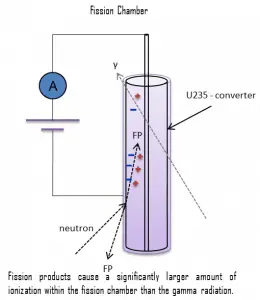 Fission chambers are ionization detectors used to detect neutrons. Fission chambers may be used as the intermediate range detectors to monitor neutron flux (reactor power) at the intermediate flux level. They also provide indications, alarms, and reactor trip signals. The design of this instrument is chosen to provide overlap between the source range channels and the full span of the power range instruments.
Fission chambers are ionization detectors used to detect neutrons. Fission chambers may be used as the intermediate range detectors to monitor neutron flux (reactor power) at the intermediate flux level. They also provide indications, alarms, and reactor trip signals. The design of this instrument is chosen to provide overlap between the source range channels and the full span of the power range instruments.
In general, the ionization chamber, also known as the ion chamber, is an electrical device that detects various types of ionizing radiation. The voltage of the detector is adjusted so that the conditions correspond to the ionization region, and the voltage is insufficient to produce gas amplification (secondary ionization). Ionization chambers are preferred for high radiation dose rates because they have no “dead time,” a phenomenon that affects the accuracy of the Geiger-Mueller tube at high dose rates. Moreover, in the ionization region, an increase in voltage does not cause a substantial increase in the number of ion pairs collected. The number of ion pairs collected by the electrodes equals the number of ion pairs produced by the incident radiation. It depends on the type and energy of the particles or rays in the incident radiation.
In the case of fission chambers, the chamber is coated with a thin layer of highly enriched uranium-235 to detect neutrons. Neutrons are not directly ionizing and usually have to be converted into charged particles before they can be detected. A thermal neutron will cause an atom of uranium-235 to fission, with the two fission fragments produced having high kinetic energy and causing ionization of the argon gas within the detector. One advantage of using uranium-235 coating rather than boron-10 is that the fission fragments have much higher energy than the alpha particle from a boron reaction. Moreover, the fission fragments resulting from the interaction of neutrons with the coating cause a significantly larger amount of ionization within the fission chamber than the gamma radiation incident on the detector. This results in the neutron-generated charge pulses being significantly larger than the gamma pulses. Pulse size discrimination circuitry can then be used to block out the unwanted gamma pulses. Therefore fission chambers are very sensitive to neutron flux, and this allows the fission chambers to operate in higher gamma fields than an uncompensated ion chamber with boron lining.
Fission chambers are often used as current indicating devices and pulse devices depending on the neutron flux level. In the pulse mode, fission chambers are especially useful due to the very large pulse size difference between neutrons and gamma rays. When power is high in the intermediate range or the power range (i.e., in a high level mixed gamma and neutron flux), fission chambers can be operated in Campbelling mode (also known as “fluctuation mode” or “mean square voltage mode”) to provide reliable and precise neutron related measurements. The Campbelling technique eliminates the gamma contribution because the fission chamber’s dual use is often used in “wide range” channels in nuclear instrumentation systems.